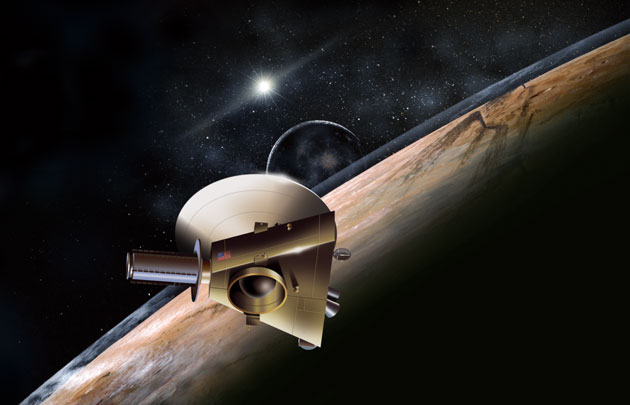 |
|||||
| New Horizons over Mysterious Pluto | |||||
| Faraway | History | Planet | Moons | Spacecraft | Go Now |
It's a Warm Winter on Pluto
LATEST NEWS ON NEW HORIZONS » IT'S A WARM WINTER ON PLUTO »
One might have imagined that a Winter's chill would have brought some shrinkage to Pluto's atmosphere. Not so, according to researchers at the Massachusetts Institute of Technology and others.
The surprised astronomers, looking through the Hubble Space Telescope (HST) at the little planet out at the edge of the Solar System, saw Pluto's atmosphere expanding even as it was moving away from the Sun.
Scientists had supposed the atmosphere – mostly nitrogen – would contract as the planet moved away from the Sun and into its winter. Instead, the planet's temperature appeared to have gone up by slightly more than 1.8° Fahrenheit (1° Celsius) since its closest approach to the Sun in 1989. Of course, it's still quite cold at -390° to -275° F.
The team suggested the temperature increase may be something like a heat-lag they have experienced here on Earth. For example, even though our Sun is highest at noon on a hot day, the warmest temperatures come a few hours later.
Out there on Pluto, such a lag could last for decades. Winter lasts for more than six decades as Pluto travels its 248-year orbit around the Sun.
Who can say what will happen across the entire season?
How do they measure that? Pluto's atmosphere also seemed to have become larger.
The researchers discovered the changing size of the atmosphere by comparing what they saw when a bright star passed behind the planet in 1988 and then again in 2002.
To measure a distant planet like Pluto, astronomers look for "stellar occultations," when starlight passes through a planet's atmosphere.
The atmosphere surrounding Pluto has been known only since astronomers observed an occultation in 1985. They then did some measuring during an occultation in 1988 and again in 2002. They found that atmospheric pressure had doubled over 14 years.
To get a closer look at what's going on out near the edge of the Solar System, NASA would like to send a probe called New Horizons to Pluto and Charon in January 2006. If successful, it would arrive in 2015. Pluto is the only planet in our Solar System that never has been visited by spacecraft from Earth.
Not your typical planet? Pluto is an unusual planet. For instance:Some naysayers go as far as to suggest that Pluto really can't be a planet. They look at it as part of a collection of small icy bodies lying beyond planet Neptune in an area known as the Kuiper Belt.
- it is smaller than Earth's Moon
- Its highly eccentric orbit doesn't line up with the other planets
- Its distance from the Sun varies by 1.86 billion miles during one of its years
SOURCE: Nature 424, 165-168 (2003)
Learn more about Pluto...About Pluto, Charon, the new moons and the Kuiper Belt
- Facts about Pluto SEDS Nine Planets
- New Moons Around Pluto Images and information
- Facts about the Kuiper Belt and the Oort Cloud
- Exploring Pluto Smithsonian Institution National Air and Space Museum
- The Struggles to Find the Ninth Planet by Clyde W. Tombaugh
- Many Pluto Web Pages
About New Horizons spacecraft and former Pluto-Kuiper Express
- New Horizons JHU APL
- The Pluto-Kuiper Express NASA JPL
- The Planetary Society
About the IAU Pluto Status Change Proposal
- Much Ado About Pluto NASA story
- The status of Pluto IAU Press Release 1999
- What is a planet? IAU discussion of Pluto's status
About the mystery object Quaoar beyond Pluto
- Quaoar FAQ CalTech
- The Kuiper Belt and the Oort Cloud SEDS
- Artist illustrations of Quaoar STScI
- Comparison of Quaoar with the Moon NASA artist
- Comparison of Quaoar with North America NASA artist
About Astrophysics and Pluto
- Science @ NASA NASA research on the web
- NASA Space Science News NASA Office of Space Science press releases
| Pluto: | Faraway | History | Planet | Moons | Spacecraft | Go Now | Internet Resources |
| Solar System | Search STO | STO Cover | Copyright 2006 Space Today Online | ||||
